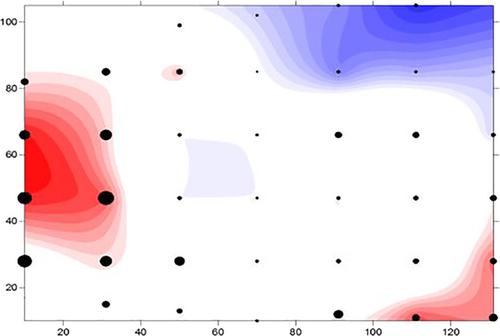当前位置:
X-MOL 学术
›
Ann. Appl. Biol.
›
论文详情
Our official English website, www.x-mol.net, welcomes your
feedback! (Note: you will need to create a separate account there.)
Molecular and spatial analyses reveal new insights on Bois noir epidemiology in Franciacorta vineyards
Annals of Applied Biology ( IF 2.2 ) Pub Date : 2021-02-22 , DOI: 10.1111/aab.12687 Fabio Quaglino 1 , Alessandro Passera 1 , Monica Faccincani 2 , Abdelhameed Moussa 1 , Alberto Pozzebon 3 , Francesco Sanna 3 , Paola Casati 3 , Piero Attilio Bianco 3 , Nicola Mori 4
Annals of Applied Biology ( IF 2.2 ) Pub Date : 2021-02-22 , DOI: 10.1111/aab.12687 Fabio Quaglino 1 , Alessandro Passera 1 , Monica Faccincani 2 , Abdelhameed Moussa 1 , Alberto Pozzebon 3 , Francesco Sanna 3 , Paola Casati 3 , Piero Attilio Bianco 3 , Nicola Mori 4
Affiliation

|
Bois noir (BN) grapevine disease is associated with ‘Candidatus Phytoplasma solani’ (CaPsol), a pathogen with a complex ecology including multiple insect vectors and plant hosts. A key point to improve the effectiveness of BN control strategies consists in determining the epidemiological role of ground-cover weeds. The present study employed a multidisciplinary approach, based on the application of spatial (spatial analysis by distance indices) and molecular (stamp gene typing) analyses, to identify weeds with a potential role in BN epidemiology in northern Italy. Generated data showed that in addition to Convolvulus arvensis, one of the main CaPsol inoculum sources, Chenopodium album, Polygonum aviculare and Trifolium repens were found associated with BN epidemiology. CaPsol molecular typing highlighted that the strains prevalent in symptomatic grapevines were characterised by stamp sequence variants St19, St11 (nettle-related) and St5 (bindweed-related). The latter was prevalent also in Hyalesthes obsoletus and weeds, suggesting their main association with bindweed-related epidemiology. On the other hand, nettle-related CaPsol strains were occasionally found in H. obsoletus and weeds. Considering that H. obsoletus-mediated transmission of CaPsol occurs mainly with young instars, further investigations will confirm if, in addition to bindweed and nettle, weeds associated with BN epidemiology in Franciacorta can represent larval developmental hosts and, consequently, act as CaPsol reservoirs for transmission to grapevine. Moreover, other studies are needed to clarify the relationship between such weeds and CaPsol alternative vectors.
中文翻译:

分子和空间分析揭示了对 Franciacorta 葡萄园黑森林流行病学的新见解
Bois noir (BN) 葡萄藤病与' Candidatus Phytoplasma solani' (CaPsol) 相关,这是一种具有复杂生态的病原体,包括多种昆虫载体和植物宿主。提高 BN 控制策略有效性的一个关键点在于确定地被植物杂草的流行病学作用。本研究采用多学科方法,基于空间(距离指数的空间分析)和分子(标记基因分型)分析的应用,以确定在意大利北部 BN 流行病学中具有潜在作用的杂草。生成的数据显示,除了Convolvulus arvensis,主要的 CaPsol 接种源之一,Chenopodium album,Polygonum aviculare和三叶草被发现与 BN 流行病学有关。CaPsol 分子分型强调,在有症状的葡萄藤中流行的菌株的特征是印章序列变体 St19、St11(荨麻相关)和 St5(旋花相关)。后者在Hyalesthes obsoletus和杂草中也很普遍,表明它们主要与旋花相关的流行病学有关。另一方面,偶尔在H. obsoletus和杂草中发现荨麻相关的 CaPsol 菌株。考虑到H. obsoletus介导的 CaPsol 传播主要发生在幼龄期,进一步的研究将证实,除了旋花和荨麻,与 Franciacorta 中 BN 流行病学相关的杂草是否可以代表幼虫发育宿主,因此,作为 CaPsol 储存库,传播到葡萄藤。此外,还需要其他研究来阐明此类杂草与 CaPsol 替代载体之间的关系。
更新日期:2021-02-22
中文翻译:

分子和空间分析揭示了对 Franciacorta 葡萄园黑森林流行病学的新见解
Bois noir (BN) 葡萄藤病与' Candidatus Phytoplasma solani' (CaPsol) 相关,这是一种具有复杂生态的病原体,包括多种昆虫载体和植物宿主。提高 BN 控制策略有效性的一个关键点在于确定地被植物杂草的流行病学作用。本研究采用多学科方法,基于空间(距离指数的空间分析)和分子(标记基因分型)分析的应用,以确定在意大利北部 BN 流行病学中具有潜在作用的杂草。生成的数据显示,除了Convolvulus arvensis,主要的 CaPsol 接种源之一,Chenopodium album,Polygonum aviculare和三叶草被发现与 BN 流行病学有关。CaPsol 分子分型强调,在有症状的葡萄藤中流行的菌株的特征是印章序列变体 St19、St11(荨麻相关)和 St5(旋花相关)。后者在Hyalesthes obsoletus和杂草中也很普遍,表明它们主要与旋花相关的流行病学有关。另一方面,偶尔在H. obsoletus和杂草中发现荨麻相关的 CaPsol 菌株。考虑到H. obsoletus介导的 CaPsol 传播主要发生在幼龄期,进一步的研究将证实,除了旋花和荨麻,与 Franciacorta 中 BN 流行病学相关的杂草是否可以代表幼虫发育宿主,因此,作为 CaPsol 储存库,传播到葡萄藤。此外,还需要其他研究来阐明此类杂草与 CaPsol 替代载体之间的关系。











































 京公网安备 11010802027423号
京公网安备 11010802027423号